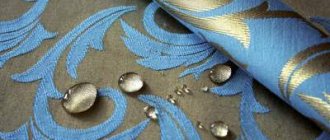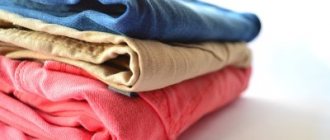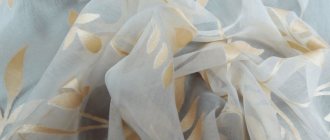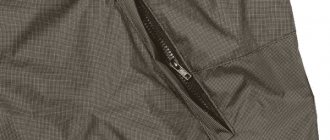How to wash an angora - products that are warm and pleasant to the touch. They still have an attractive appearance, but only if they are properly cared for. Ignorance about care and washing can completely ruin an expensive and beloved item. This is why many people hand over angora items to professionals for cleaning. But is it worth spending money on dry cleaning services when you can do everything yourself? If you want to learn how to wash an angora in a washing machine, read our article carefully.
How to care for things made from angora
Angora is a fabric made from the softest goat or rabbit fluff.
The question often arises: how to wash things made from angora? This fabric is very pleasant to the touch and warm. But at the same time it is very capricious in care. How to care for angora and whether it can be washed depends on the composition of the fabric.
Natural angora consists of down from goats or special breeds of rabbits.
One hundred percent natural Agnora is the most expensive, but it is also the most capricious. Items made from Angora wool without the addition of synthetics cannot be washed either by hand or in a washing machine. Such things can deteriorate even from slight wetness, for example, in the rain.
Things made from pure angora cannot be called practical and wear-resistant. These are rather exclusive items for special occasions.
How to care for things made from pure angora:
- do not wet, do not wash;
- If exposed to rain, dry it in a horizontal position, placing it on a terry towel;
- take it to the dry cleaner once or twice a year;
- do not iron;
- smooth by hanging the item over steam;
- store in a case on soft hangers;
- use moth repellents.
Handwash
For impeccable washing, we need any baby soap, preferably white and without additional dyes and creams, as well as glycerin, which is sold at any nearby pharmacy or specialized soap making store.
Important! It is not recommended to use conventional washing powders, aggressive agents and bleaches.
Even despite the advertising specifications, which indicate that they are intended for such material, you can ruin the thing.
For reference! Soap can be replaced with regular baby shampoo, but this risks creating too much foam during washing and then removing it will be very problematic, so it’s better to opt for soap.
Then we collect water into the container where we will do the washing; the water temperature should not exceed forty degrees, and preferably in the range of 36–37. It’s easy to check even without a thermometer, just drop some water on the back of your wrist and if you feel a difference, you just need to adjust the temperature by adding warm or cold water.
Next, crumble the soap, perform this operation with a kitchen knife to obtain thinner chips and add a spoonful of glycerin. Mix the resulting composition thoroughly and lower the sweater into it. Be sure to turn the item inside out before washing. We wash it carefully and carefully, and then rinse it; it is advisable to repeat this procedure several times.
Important! After rinsing, you should lightly wring out the sweater without using force, otherwise you will deform the fabric. The next stage is drying, we’ll talk about this later.
What items made from angora can be washed?
To increase the wear resistance of angora, ordinary wool, nylon, viscose, silk, and other natural and artificial fibers are added to it. The higher the percentage of synthetics in the fabric, the better it tolerates washing.
You can wash items made from angora if the angora wool content in the fabric is less than 50 percent.
But even such angora products must be washed very carefully.
First of all, you need to choose a suitable detergent.
Features of Angora
Today you can find items made from mixed materials: a mixture of merino and llama wool, acrylic, viscose and polyester. Products with the addition of synthetic fibers are the most affordable and durable, but during use they lose their thermal insulation properties and aesthetic appearance.
A mixture of angora down and natural materials, such as wool, creates more refined, elegant and luxurious products. They retain their thermal insulation qualities longer, but are also more expensive.
But the most popular due to their availability, strength and durability are products with the addition of synthetic fibers. Most often, these are things with a down content of 10-20%, acrylic 50% and polyester 40%.
How you can and cannot wash angora products
How to wash items made from angora wool with synthetic fibers:
- baby shampoo without sulfates, fragrances and dyes;
- gel for washing woolen items;
- baby or laundry soap with glycerin.
How to wash angora with laundry or baby soap:
- grate the soap and completely dissolve it in warm water, up to 40 degrees, so that there are no undissolved pieces left;
- beat water and soap into foam;
- add a teaspoon of glycerin;
- very delicately wash the angora with your hands without rubbing or twisting;
- Rinse several times in clean water and then with a special wool rinse or glycerin.
But it is still better to wash angora with shampoo or liquid detergents for delicate wool washing.
How not to wash things made from angora:
- ordinary washing powder, since it is difficult to rinse out of angora wool fibers;
- products containing bleaches;
- detergents containing enzymes destroy the fiber structure.
Restoring angora clothing
Even if a jacket or other clothing has lost its appearance, you can try to restore it. To do this, do not rush to the store for special expensive products. The most effective formulations can be found in every home.
How to wash an angora sweater to restore its softness and fluffiness:
- Freezer. This is the simplest method that does not require additional investment. The angora sweater should be placed in a clean plastic bag and placed in the freezer. Leave it there overnight. After this, lay the clothes out on a horizontal surface and let them warm up to room temperature. This extreme method will restore elasticity and shine to the fibers.
- Glycerol. It is better to purchase it immediately along with angora clothing. While rinsing, add 1 teaspoon of product to the water. It is recommended to repeat this procedure every time you wash.
- Turpentine and ammonia. Fill a bucket with warm water. Grate half a bar of laundry soap on a coarse grater and dissolve in water. Add 1 tbsp to soapy water. l turpentine and 2 tbsp. l ammonia. Soak the jacket overnight. It is not recommended to keep the product for longer than 12 hours. After this, rinse with an appropriate conditioner and dry.
- Ammonia and medical alcohol. It is necessary to dissolve 1 cup of soap shavings in a bucket of warm water. Stir and add 15 ml of ammonia and 5 ml of pure medical alcohol. Soak clothes. After 10-12 hours, remove the product, remove excess moisture, and dry a little with a terry towel. Lay the jacket out on the table and cover the top with a thin cotton cloth. Iron and finish drying.
After final drying, the items should be combed with a wide-toothed brush.
Is it possible to wash angora clothes in a washing machine?
The answer to this question must be found on the product tag. Typically, if an item can be washed by hand, it can also be washed in a washing machine on a delicate cycle without spinning.
How to wash angora in a washing machine:
- put the item in a laundry bag;
- pour liquid wool detergent into the detergent compartment (shampoo cannot be poured into the washing machine due to strong foaming);
- also fill the conditioner into the corresponding compartment of the washing machine;
- select a mode for washing wool or for delicate washing, without spinning;
- temperature - up to 40 degrees.
After washing, remove the item from the washing machine and place it in the bathtub or sink to drain.
Is pre-soaking necessary?
Before washing a white angora beret, you need to soak the product in a specially prepared solution. It includes:
- detergent – 50 g;
- table salt – 5 tbsp. spoon;
- ammonia – 20 ml;
- hydrogen peroxide – 20 ml.
The product immersed in the solution must be turned over several times. After three hours, you can start washing the beret or jacket using any detergent: shampoo, soap, gel.
After the operation is completed, the product must be rinsed several times and always in new water.
How to dry an angora after washing
When the water has drained, the angora item is carefully wrapped in a terry towel and lightly blotted.
Then they are laid out flat on a dry terry towel. From time to time the towel must be changed for a dry one and the item must be turned over.
When the angora dries, you need to restore the pile. You can shake the item several times, then comb it with a soft brush along the pile, and then against the pile.
There is another way:
- put the item in a bag, remove air from the bag;
- place in the freezer for a day;
- pull out, hang on soft hangers and smooth over a pan of hot water or using a steamer.
So, we found out that you can wash angora items by hand and in a washing machine if they contain 50 percent or more synthetics. One hundred percent angora cannot be washed, it must be dry cleaned.
Program selection
Each automatic washing machine has several programs designed to process various materials. Gentle washing is carried out using the “Delicate” mode. During spinning, the rotation speed of the drum decreases, preventing damage to the product. This mode is suitable for washing: silk, satin, viscose, angora, wool.
When the delicate mode is set, the drum operates intermittently. This allows you to completely eliminate deformation of a delicate item.
How to wash a jacket: simple rules
Knitted items require special and careful care.
To preserve their magnificent original appearance for a long time, you need to follow a few simple rules.
To begin with, you need to carefully study all the tags on the reverse side; as a rule, they give precise care recommendations depending on the composition of the material. As a rule, these are recommendations on water temperature and the possibility of using bleaching agents.
Is it machine washable?
The only question that the tags do not answer is: how exactly to wash the jacket. Most modern washing machines provide for washing knitwear, but as practice shows, it is better to safely put only tightly knitted items made from thick yarn or with a high content of synthetic fibers into the machine.
In order for the jacket to deform as little as possible during the washing process, it must be placed in a special bag; by the way, it will protect it from possible creases on the fabric that may occur during spinning.
The water temperature should be no more than 30 degrees. Choose the most delicate mode that your machine has, best for wool, even if the item does not contain natural fibers.
Not only the preservation of the structure of the knitwear fibers depends on this, but also the brightness of the color of the item, which may suffer from washing.
Items made of dense, thick knitwear can be safely wrung out in the machine - the usual 1000 revolutions will not cause damage to them. But clothes made of thin, especially woolen or openwork knitwear, are best rinsed in the washing machine. And gently, without twisting or pulling, squeeze by hand. It is good to use a terry towel for this purpose.
How to properly wash a knitted sweater
Knitted items, especially handmade ones, should not be trusted even in the most modern washing machine. They are washed exclusively by hand, in compliance with their own rules, especially if the knitted fabric contains wool.
If you wash a wool sweater like an ordinary item, the result can be unpredictable.
Special detergents and rinsing agents designed for woolen and delicate fabrics cope best with the task.
Natural fibers - and wool is no exception - do not tolerate sudden changes in temperature, so for both washing and rinsing you need to use lukewarm water, no higher than 30 degrees. Completely dissolve the detergent in water, whip up a light foam and carefully immerse the item in it. If it is very dirty, you can keep it in water for a short time, no more than half an hour.
The main thing is to wash a knitted sweater as gently as possible; do not twist, rub or wrinkle it. There is no need to keep the item in water for as long - no longer than 10-15 minutes, this time is enough for the fibers to absorb water.
To prevent the knitwear from matting and pilling from appearing on it - and this can happen even with the highest quality items - softening agents must be added to the water during the last rinse. This can be either a special product for wool or regular baking soda at the rate of 1 tablespoon per 5 liters of water. At the same time, the wool fibers will straighten out, fluff up and take on their original appearance.
If there is a need to slightly stretch the item, you can use ordinary tailor's pins. Having carefully straightened and slightly stretched the edges, secure them to the fabric of the towel.
The same is done if the item has a fine openwork knit without elastic on the cuffs and along the bottom edge or is trimmed with scallops.
If there are doubts about the decor - collars, flounces or embroidered elements, in order to avoid deformation, it is also better to fix them with pins.
Drying and restoration of pile
The washed angora model must be properly dried. This is done like this:
- The item is wrapped in a fabric that absorbs moisture well, for example: a flannelette diaper or terry towel, and lightly crimped.
- An oilcloth is laid on a horizontal surface, and a dry cloth is laid on top of it (preferably in several layers).
- The item made from Angora wool is carefully laid out on a prepared place to dry. When the litter is saturated with moisture, it is replaced and the model is turned over.
If the headdress is being dried, it is placed in a wet state on a jar, plate or ball of a suitable size.
When the product is completely dry, it is necessary to restore its main advantage - fluffy pile. You can do this in several ways:
- The model is shaken several times and then combed with a soft brush: first along the pile, and then against it.
- Angora is rolled up and placed in a plastic bag. The container is freed from excess air by hand, tied and placed in the freezer for 15-20 hours.
- The product is suspended on soft hangers over steam, for example: rising from a just boiled pan or tap with very hot water.
You cannot touch the delicate pile with a regular iron. The crumpled product is straightened using a steam iron or household steamer.
Thus, it is possible to preserve an angora item in its original form only if it is properly cared for.
Source
Some final useful tips
In order for angora items to last longer as mono, you should follow a few simple rules. How to extend the life of an Angora:
- Of all the new things, angora fluff will come out in large quantities. This is the norm. This is the peculiarity of this material. But the amount of fluff that falls out can be reduced somewhat. To do this, simply wash angora items in the required mode. After things dry, you need to shake them thoroughly. This will remove loose lint.
- There is no need to change the temperature of the washing and rinsing water much. A sharp drop has an aggressive effect on the fibers and they will lose their elasticity, which is extremely undesirable for the quality of the item.
- Always wash items on the wrong side only, this will help maintain the integrity of the fibers.
- Before cleaning, be sure to sew up buttonholes, if any. Otherwise, the loops are easy to stretch during the washing process.
Thus, it is not difficult to wash angora clothes; it is only important to follow the regime and choose a safe detergent for washing. If these conditions are met, the product will easily survive repeated machine and hand washes and at the same time retain its appearance and unique properties.
Many housewives are annoyed after washing when they see that their colored linen has faded. How to wash correctly, Items made of viscose look very beautiful and bright, but due to improper care they become very fast, Natural fabrics are expensive, but cause certain difficulties when washing. To remove contaminants you will need, Properly washing and drying a down jacket is a whole science, because due to poorly selected
Source
What can I do to prevent my sweater from getting in?
Soak the “shrunken” item in warm water with shampoo, then, without squeezing, wrap it in a terry towel and leave for half an hour. Unfold and carefully stretch the item to the desired size. And after the procedure, lay it out to dry in a horizontal position. Ready!
Interesting materials:
Why doesn't megogo work on my TV? Why isn't Microsoft Store working? Why doesn't the microphone work in iPhone apps? Why doesn't the microphone work on Skype? Why doesn't the microphone work in ZOOM? Why doesn't the mouse work but is lit? Why doesn't Wallet work on iPhone? Why doesn't the navigator work without the Internet? Why doesn't Need for Speed Underground 2 work? Why does NFC not work on Xiaomi Redmi Note 8 Pro?
Hand and machine washable
In relation to items made of delicate knitwear, you should be guided by the following rule: the less rabbit fluff they contain, the easier they are to care for. Therefore, when choosing a washing method, first of all, you should pay attention to the composition of the fabric and the manufacturer’s recommendations.
You can only wash products containing 10-50% angora. Premium items made from natural fiber are taken to professional dry cleaning 1-2 times a year.
Models that are not harmed by contact with water are best washed in a gentle way, that is, by hand. In this case, it is necessary to follow the following procedure:
- The product is turned inside out. The loops on the jacket and coat are sewn up with a temporary seam, and the voluminous collar is sewn to the main fabric of the sweater in the same way. If this is not done, these parts will stretch.
- Water is poured into the washing container. Its temperature should not exceed 40° (optimally 30-35°). In hotter water, textiles will shrink significantly and the pile will fall off.
- The selected detergent is dissolved in a basin, then the knitted item is immersed in it. Soaking time should not exceed 15 minutes. The exception is when the model needs to be bleached. Then it is left in the liquid for several hours.
- Even with high-quality twisting of the angora thread, it climbs a lot. To minimize this process during washing, the product should not be rubbed with your hands. It is lightly squeezed with your palms in different places, turning it over from time to time.
- Rinse a clean model several times, changing the water. The temperature of the rinse water should not differ from that selected for the main wash. During the last rinse, industrial conditioner or glycerin (1 tsp) is poured into the basin.
- The product is placed in an empty container and wait until most of the water has drained. Squeezing and twisting the fabric is prohibited.
When processing angora in a washing machine, you must follow the following rules:
- Prepare the product in the same way as for hand washing, carefully fold it and place it in a mesh bag. Only after that put it in the drum.
- Pour liquid detergent and conditioner into the machine's ditch.
- On the panel, select the “wool” or “delicate wash” mode. Disable “drying” and “spin”.
- Remove the clean item from the net and let it drain in an empty container.











